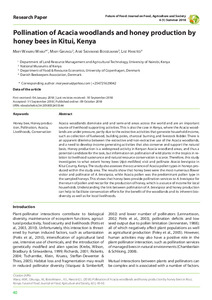| dc.date.accessioned | 2018-10-16T12:21:05Z | |
| dc.date.available | 2018-10-16T12:21:05Z | |
| dc.date.issued | 2018-10-09 | |
| dc.identifier.issn | 2197-411X | |
| dc.identifier.uri | urn:nbn:de:hebis:34-2018052455544 | |
| dc.identifier.uri | http://hdl.handle.net/123456789/2018052455544 | |
| dc.language.iso | eng | |
| dc.publisher | Section Specialized Partnerships in Sustainable Food Systems and Food Sovereignty at the University of Kassel, Germany and Federation of German Scientists (VDW) | ger |
| dc.rights | Urheberrechtlich geschützt | |
| dc.rights.uri | https://rightsstatements.org/page/InC/1.0/ | |
| dc.subject | Honey bee | eng |
| dc.subject | Honey production | eng |
| dc.subject | Pollination | eng |
| dc.subject | Acacia | eng |
| dc.subject | Livelihoods | eng |
| dc.subject | Conservation | eng |
| dc.subject.ddc | 630 | |
| dc.title | Pollination of Acacia woodlands and honey production by honey bees in Kitui, Kenya | eng |
| dc.type | Aufsatz | |
| dcterms.abstract | Acacia woodlands dominate arid and semi-arid areas across the world and are an important source of livelihood supporting activities. This is also the case in Kenya, where the Acacia woodlands are under pressure, partly due to the extractive activities that generate household income, such as collection of fuelwood, building poles, charcoal burning and livestock fodder. There is an apparent dilemma between the extractive and non-extractive use of the Acacia woodlands, and a need to develop income generating activities that also conserve and support the natural basis. Honey production is a widespread activity in Kenyan Acacia woodland areas, and thus a potential candidate for the task, but information on pollination of wild plants in the tropics in relation to livelihood sustenance and natural resource conservation is scarce. Therefore, this study investigates to what extent honey bees (Apis mellifera) visit and pollinate Acacia brevispica in Kitui County, Kenya. The study also assesses the occurrence of Acacia pollen types in honeys produced within the study area. The results show that honey bees were the most numerous flower visitor and pollinator of A. brevispica, while Acacia pollen was the predominant pollen type in the sampled honeys. This shows that honey bees provide pollination services to A. brevispica for the return of pollen and nectar for the production of honey, which is a source of income for local households. Understanding the link between pollination of A. brevispica and honey production can help to facilitate conservation efforts for the benefit of the woodlands and its inherent biodiversity as well as for local livelihoods. | eng |
| dcterms.accessRights | open access | |
| dcterms.bibliographicCitation | In: Future of Food: Journal on Food, Agriculture and Society. Witzenhausen : University of Kassel, Specialized Partnerships in Sustainable Food Systems and Food Sovereignty. - Vol. 6, No. 1 (2018), S. 40-50 | |
| dcterms.creator | Warui, Mary Wanjiru | |
| dcterms.creator | Gikungu, Mary | |
| dcterms.creator | Bosselmann, Aske Skovmand | |
| dcterms.creator | Hansted, Lise | |

